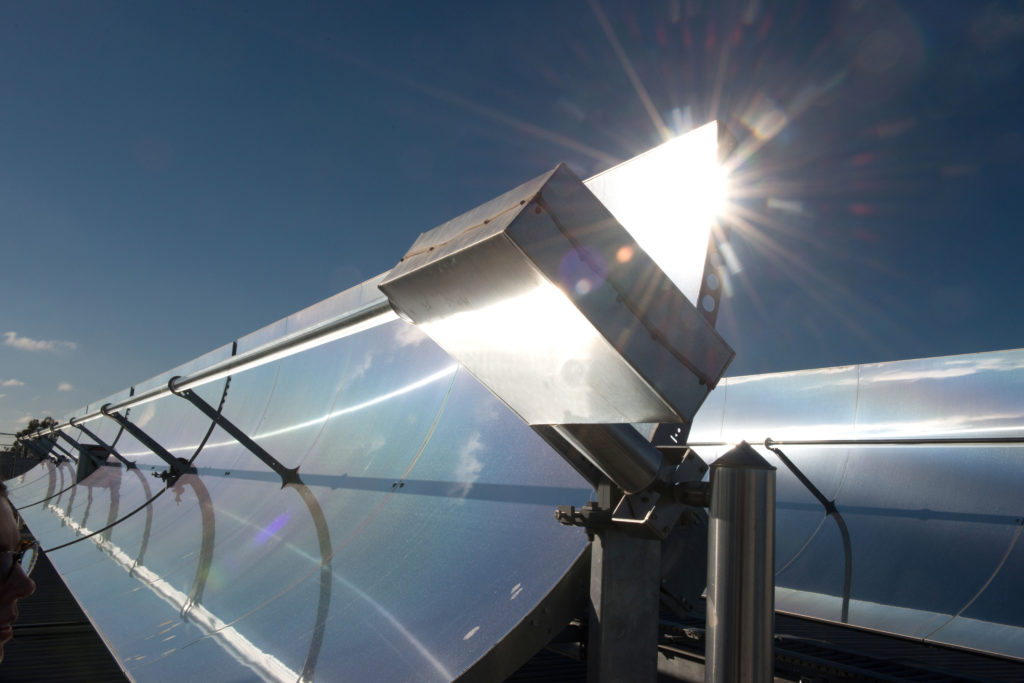We've created a breakthrough solar cooling technology that will help large commercial spaces to achieve lower emissions.

We hope our solar cooling technology will help commercial spaces to achieve lower emissions. Image credit – Detsang/Flickr
The next time you’re strolling around your local shopping centre, consider the temperature. Are you hot, cold or just right? Did you know that large commercial spaces such as these use around 60% of their total energy use on heating and cooling? We think that’s a lot so we’ve developed some snazzy solar cooling technology to achieve better energy efficiency. In fact, this technology is quite a breakthrough and hasn’t been used before.
Our solar-powered air-conditioning system at Stockland Wendouree Shopping Centre in Ballarat, Victoria, is a leading example of how to use the sun to cool Australian buildings. Using concentrating solar thermal (CST) technology, the system produces its own heat energy to power the air-conditioning, which results in less cost to the business.
But we couldn’t do this alone. We love partnering with like-minded organisations that recognise the importance of delivering energy innovation. The Australian Renewable Energy Agency (ARENA) provided $520,000 support toward to the $1.2 million, three-year project, jointly managed by us with Stockland Group and NEP Solar.
What makes this technology so cool?
Without getting too technical, the closed-loop system uses two ‘desiccant’ wheels to remove moisture from the air, acting as a dehumidifier. A high temperature wheel uses solar heat for regeneration while the low temperature wheel functions without any external heat to deliver greater efficiency. An indirect evaporative cooler reduces the temperature of the dehumidified air without altering the moisture content of the air stream.
To give you a better visual idea, NEP’s solar troughs are installed on Stockland Wendouree’s rooftop, trapping heat from the sun. This heat is stored in a thermal oil tank to deliver space heating and cooling. The roof space required for this cutting-edge technology can be 40% less than a traditional single stage desiccant air-conditioning system. It also allows humidity-controlled fresh air into the building to deliver temperature comfort.

Our solar-powered air-conditioning system at Stockland Wendouree Shopping Centre in Ballarat, Victoria.
Our solar-powered air-conditioning system at Stockland Wendouree Shopping Centre in Ballarat, Victoria.
Concentrating on an efficient future
Our Energy Director, Peter Mayfield, is pleased as punch with the early results.
“Our energy research is driving down costs of renewable technologies, accelerating the transition to a lower-emissions future. We are pioneering new technologies and this project is a world-first demonstration of a desiccant air conditioning system using roof-mounted concentrating solar thermal collectors to drive energy efficiency.”
We’re not the only ones who are excited about the future of this technology, ARENA CEO Ivor Frischknecht is on board to help us make a positive impact.
“It has the potential to further improve the efficiency of solar thermal energy systems and storage to provide clean and reliable heating and cooling in commercial buildings.”
We will continue to assess and monitor the technology for the next 12 months to establish long-term commercial operations and further investment as part of our commitment to creating a low emissions future for Australia.
Get up to speed with our leading research into solar cooling technologies.


12th July 2016 at 11:21 am
Bill Ellul B.E(Hons) FIEAust MAIRAH ex CSIRO
Hi Frank
You are right, nearly 50 years ago this is exactly the solar air conditioning cycle based on Chief Scientist of the Division of Mech Eng RV Dunkle had proposed. The unique high efficiency Mylar sensible heat rotary heat exchanger developed by CSIRO was a spinoff from this research.R&D to develop the descant dehumidifier and total heat dehumidifying wheels were also aimed at the same cooling cycle project.
Having read the published ARENA report. it is clear that the cooling component of this open cycle cooling system is the indirect evaporative cooling operation. The solar heating component is purely to regenerate the desicant dehumidification of fresh air in order to increase the efficiency of indirect evaporative cooling when ambient environment is humid. From studies I have conducted while at CSIRO as well as by others this dehumidification stage is only recquired in more tropical environments and not in drier ares such as Ballarat. A major cost of this installation is associated with the heating system. Maybe absorption refrigeration could have been considered. The low thermal COP (0.66) could have been improved.
Another point of concern is the extremely low 305l/s air flow and low maximum cooling of 10kW. I estimate that a simple and small indirect evaporative cooling system incorporating an evaporative cooler one 1m diam high efficent rotary heat exchanger and two small fans in Ballarat would have easily doubled this capacity without the need of the solar heating and storage system.
14th July 2016 at 1:13 pm
Hello Bill,
Thanks for the memory refresher. My recollection of appropriate technical terms has seriously faded. Bob Dunkle, a great and clever man.
31st January 2017 at 10:37 pm
Hi Frank and Bill,
Bob Dunkle was my Dad and I often think it would have been wonderful if he could have known that finally we are coming round to solar energy applications. It made me very happy to know from your comments that he is not altogether forgotten. As you would know, he was passionate about trying to protect our planet.
Kind regards,
Kathleen Dunkle Graham
5th February 2017 at 4:58 am
Hi, Frank and Bill,
I am Dorothy, the third and youngest of Bob’s daughters, and living in sunny Israel. I was tremendously moved to find that he has not been forgotten and that the his simplicity and greatness of innovation are still highly regarded. My eldest son read this article as well and is interested in implementing this research here in building a new house on our farm, and he would love to get some links to any material published detailing methods and practical issues. doradzyner@gmail.com